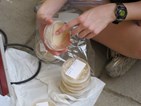S&T Water Study: Is Colloidal Silver Necessary For Bacteria Removal?

Nicole Heinley, a graduate student at Missouri University of Science and Technology, traveled to Guatemala twice in the past year to conduct research on ceramic pot filters that are used locally to remove bacteria from water. Now, Heinley's findings are about to be published in the Journal of Water Science and Technology.
Ceramic pot filters, which are made out of sawdust and clay, have been around in poor countries for hundreds of years. The focus of Heinley's research is on the colloidal silver -- or lack of it -- that is typically used to line the filters. The silver mixture is thought to have disinfection properties -- but the actual disinfection mechanism of the silver is poorly understood.
Heinley wanted to find out if the colloidal silver, which is the most expensive part of the filters, is necessary at all. "It's the only material that has to be imported to manufacture the filters," she says. "The remaining materials -- sawdust and clay -- are available locally."
In the journal article, Heinley and Dr. Curt Elmore, associate professor of geological engineering at Missouri S&T, conclude that the silver may not be necessary to effectively remove bacteria from source water. In their study, filters not lined with silver removed a high rate of E. coli.
"Additional, long-term studies of filters without silver should be undertaken in order to further investigate the issue," Heinley says.
Heinley and Elmore traveled to Guatemala with students from a geological engineering class during winter break and spring break earlier this year. Heinley collected contaminated water samples from a little river in the city of Antigua and studied the structure of the ceramic pot filters available locally. Back at Missouri S&T, she continued the research.
The article, "Bacteria Removal Effectiveness of Ceramic Pot Filters Not Applied with Colloidal Silver," was recently accepted for publication by the Journal of Water Science and Technology. The publication date is pending.
3 Comments
By Wm. Carter Elliott, BS/EE (UMR), MS/EE (UCSB), formerly Dir. of R&D for 3 BioMed companies on September 1, 2010 3:11 PM
You may be missing the bigger picture regarding Colloidal Silver - it may be unnecessary in filtering water in Guatemala, but in a world where pathogens are growing ever more resistant to antibiotics and antivirals, CS has demonstrated its effectiveness against a wide range of pathogens for which there are no "FDA-Approved" alternatives. For example: http://www.jnanobiotechnology.com/content/3/1/6
"Interaction of silver nanoparticles with HIV-1"
"In this work, we demonstrate that silver nanoparticles undergo a size-dependent interaction with HIV-1, with nanoparticles exclusively in the range of 1–10 nm attached to the virus. ... Due to this interaction, silver nanoparticles inhibit the virus from binding to host cells, as demonstrated in vitro." Re: E. Coli; http://tinyurl.com/2f37lt9 Re: Malaria: http://tinyurl.com/25kqe36 How do we know that CS won't work on Ebola, Anthrax, Smallpox, the "brain-eating amoeba"? (It *does* cure the common cold, I can vouch for that, myself.)
By Steve on September 1, 2010 3:28 PM
Interesting.
Popsci had an article yesterday talking about filtering water cheaply and efficiently for areas hit with devastation like Pakistan or third world countries in general.
For those interested: http://www.popsci.com/science/article/2010-08/cotton-filter-soaked-nanotech-cheaply-and-quickly-purifies-large-volumes-water
By Milton J Murry PE on September 1, 2010 4:56 PM
Are there other elements that have same effect in nanometer size? Has anyone looked at UV in the 256nm range for post or pre treatment? NPR had a story on this technology last spring. This research maybe a nice followup. It would seem that UV or silver treatment would not give the bacteria a chance to develope defense mechanisms. See July Smithsonian page 76 for research on how to disrupt bacteria communications.
SOURCE: University of Science and Technology
